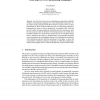1024 search results - page 15 / 205 » Complexity and Performance in Parallel Programming Languages |
PADL
2010
Springer
14 years 5 months ago
2010
Springer
Abstract. Skeletons simplify parallel programming by providing general patterns of parallel computations. When several skeletons are used inside the same program, skeleton composit...
IPPS
2009
IEEE
14 years 3 months ago
2009
IEEE
Partitioned Global Address Space (PGAS) languages provide a unique programming model that can span shared-memory multiprocessor (SMP) architectures, distributed memory machines, o...
IPPS
2000
IEEE
14 years 1 months ago
2000
IEEE
One of the keys for the success of parallel processing is the availability of high-level programming languages for on-the-shelf parallel architectures. Using explicit message passi...
ICPP
1996
IEEE
14 years 23 days ago
1996
IEEE
A primary problem in the performance measurement of high-level parallel programming languages is to map lowlevel events to high-level programming constructs. We discuss several as...
VEE
2009
ACM
14 years 3 months ago
2009
ACM
r of high-level languages lies in their abstraction over hardware and software complexity, leading to greater security, better reliability, and lower development costs. However, o...


